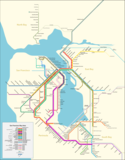For decades, Canadians moved to the larger cities (census metropolitan areas, or CMAs) with their economic opportunities. read more »
Small Cities
Canadians Are on the Move, to Smaller Communities
- Login to post comments
No Solar for Scranton Joe
Last Tuesday during his State of The Union speech, President Joe Biden repeated a claim he has made many times over the past few years about renewable energy. Biden declared that the Inflation Reduction Act is “the most significant investment ever in climate change, ever. Lowering utility bills, creating American jobs, leading the world to a clean energy future.” read more »
- Login to post comments
The Future of Cities: The Urban Future – The Great Dispersion
This chapter describes general urbanization trends in the United States and around the world, from 1950 to the present. Cities can be glamorous or exciting, but what matters most is how they facilitate higher incomes and standards of living. read more »
- Login to post comments
The Rural Character of Canada's Metropolitan Areas (CMAs)
There is considerable confusion with respect to the terms of urban geography, not only among the population in general, but also among the media, and sadly, among academics. Perhaps the greatest confusion is between the terms “metropolitan area” and “urban area.” read more »
- Login to post comments
Will Amtrak Benefit from Telecommuting?
Airlines carried 94 percent as many passengers in September 2022 as they did in September 2019, according to passenger counts published by the Transportation Security Administration. That’s up from 91 percent in August and 88 percent in September. read more »
- Login to post comments
A Better Future
In earlier times, even with a soaring population, Americans knew how to accommodate housing demand. In the eighteenth and nineteenth centuries we built cities from scratch along the frontier. The existing major urban centers—Boston, New York, Baltimore, Philadelphia—all expanded rapidly, both by density and expansion into land on the periphery. read more »
- Login to post comments
Is America Entering a New Age of Democratic Capitalism?
Most everyone outside the Biden administration knows that a recession is now more than likely. We could be entering what economist Noriel Roubini describes as the “Great Stagflation: an era of high inflation, low growth, high debt and the potential for severe recessions.” Certainly, weak growth numbers, declining rates of labor participation and productivity rates falling at the fastest rate in a half century are not harbingers of happy times. read more »
- Login to post comments
Finding Third Places Across America
Returning to New York City from a trip to Salisbury, Maryland, it is clear why so many younger Americans are so open to giving up the displeasures of a dense metropolis—high crime, high costs, and constant competition for amenities—for affordable, easy-to-navigate small-town environs like this fantastic city nestled within the Chesapeake’s Eastern Shore. read more »
- Login to post comments
Pandemic Increases Homeownership
The nation’s number of occupied homes grew by 3.9 percent between 2019 and 2021, representing 4.7 million units of new homes read more »
- Login to post comments
U.S. Auto Commuting Dips to Half Century Low
The share of workers commuting to work by auto fell to 75.6%, according to the 2021 American Community Survey (ACS), the lowest level since before the 1970 census, which reported that 77.7% of commuting was by auto (Figure 1). read more »






















